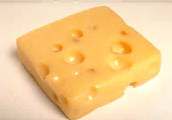Emmentaler and Gruyère Cheese
in Switzerland

By
Durant
Imboden
Cheese has long
been a staple of the Swiss diet--a fact that's hardly surprising in a nation where, until
recent times, dairy cows outnumbered bankers, foreign investors, and tourists. In
The
Swiss Cookbook, Nika Standen Hazelton writes:
Cheese was a standard food as early as in the thirteenth and fourteenth
centuries. The early cheeses were simple products made from soured milk, such as homemade
cottage cheese, and well into the nineteenth century many rural households knew no other.
The solid, lasting cheeses that we know as Swiss cheese turned up in the fifteenth
century, when they server for travelers and soldiers as one of the earlier kinds of
convenience food.
Until the 1800s, most Swiss cheeses were relatively small, weighing no
more than 10-12 pounds or about 5 kilograms. Then, as the Swiss cheesemaking industry
developed modern manufacturing methods, it became practical to make huge wheels of cheese
weighing 100 kilograms (220 lbs) or more. Today, a single wheel of Emmentaler for the
export market may be worth US $2,500 by the time it's been sawn into blocks and sold by
the slice at your local deli counter.
Two of the most popular Swiss hard cheeses are:
Emmentaler
 This pale yellow cheese is produced by some 1,600 dairies in the
Emmental Valley of German-speaking Switzerland. It has a mild, nutty taste and is
distinguished by large holes that are formed by pockets of gas during a fermentation that
lasts anywhere from three to six months. This pale yellow cheese is produced by some 1,600 dairies in the
Emmental Valley of German-speaking Switzerland. It has a mild, nutty taste and is
distinguished by large holes that are formed by pockets of gas during a fermentation that
lasts anywhere from three to six months.
In his Cheese
Primer, Steve Jenkins points out that, because the raw milk
of Emmentaler is partially skimmed, the cheese is lower in fat than many other hard
cheeses. It's also higher in quality than cheaper foreign versions. Says Jenkins:
The Swiss won't compromise on the naturalness of the product; they would
rather throw away the occasional off-batch. Their standards are the highest in the world.
Raw-milk Emmental, whether French, Swiss, or from elsewhere, is consistently memorable. It
is Emmental's pasteurized-milk imitators, such as Norwegian Jarlsberg and Wisconsin Alpine
Lace, that have reduced the status of this fine cheese.
Gruyère
This pale yellow cheese is made in smaller wheels than Emmentaler:
typically 70 to 90 lbs or about 30 to 40 Kg. It has a sharper taste than its larger
compatriot, thanks in part to an eight- to ten-month aging period. The cheese comes from
the Gruyère district of French-speaking Switzerland, where an even sharper variant called
Fribourg (after Gruyère's canton) is aged for at least two years. (Fribourg is also the
name of the cantonal capital, by the way--and just to make things even more confusing, the
center of the Gruyère district is named Gruyères with an "s.")
Gruyère becomes creamy when melted. This characteristic, along with its
tangy flavor, makes it popular in the classic Swiss fondue.
Fondue
The word "fondue" has come to mean just about anything cooked
and eaten from a common pot by diners equipped with long forks. For example, fondue
bourguignonne consists of beef chunks cooked in hot oil, while fondue orientale
is the same meat dunked in boiling beef or chicken broth. Chocolate fondue is another
variant (served as a dessert, we hasten to add).
The classic Swiss fondue, however, is made with cheese. Gruyère and
(usually) Emmentaler are chopped, tossed into an earthenware pot, and heated over a flame
with white wine, a splash of Kirsch or brandy, a small quantity of flour or cornstarch, a
sprinkling of nutmeg, and a few spoons of lemon juice. When the mixture starts bubbling,
diners poke their forks into cubes of day-old French bread and dunk for their dinners.
In Fribourg, Vacherin cheese is substituted for the usual varieties and
potatoes are used in lieu of bread. Valais fondue uses the cheese of that region, with
milk instead of wine; Geneva's fondue sometimes has fresh tomatoes added to the pot.
In Swiss restaurants, fondue is normally served to a minimum of two
persons. The traditional accompaniment is wine (not beer), which you can order by the
deci
(deciliter, or 1/10 liter) in all but the most upscale dining rooms.
Related Web sites
Emmental
The region's multilingual Web site is packed with tourism information (though
the English section has a tendency to come and go).
Emmentaler Cheese Route
Plan a trip around your favorite cheese.
La
Gruyère
Find information about the Gruyère region in French, German, and
English.
About the author:
 Durant Imboden
is a professional travel writer, book author, and editor who focuses on European
cities and transportation. Durant Imboden
is a professional travel writer, book author, and editor who focuses on European
cities and transportation.
After 4-1/2 years of covering European travel topics for About.com, Durant and
Cheryl Imboden co-founded Europe for Visitors in
2001. The
site has earned "Best of the Web" honors from Forbes and The
Washington Post.
For more information, see
About
Europe for Visitors,
press clippings, and
reader
testimonials.
|